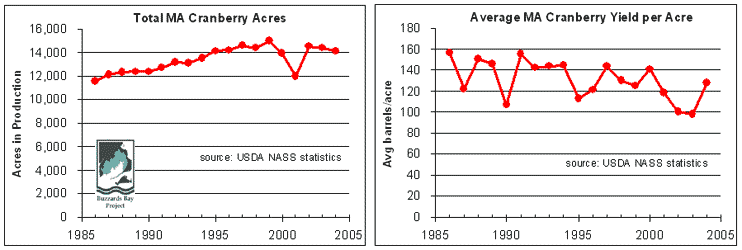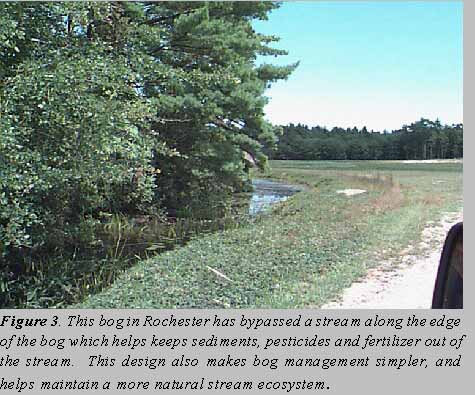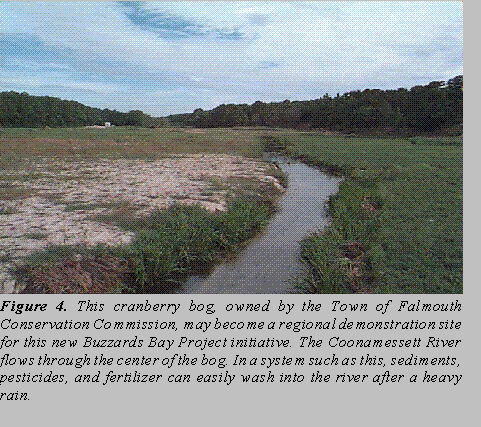Buzzards Bay Watershed Cranberry Bog Initiative
[This is the web page version of a BBP fact sheet released in 1997. Please note that DEP withdrew funding for this initiative because the proposed bog restoration site owned by the Town of Falmouth was discovered to be contaminated with EDB from a groundwater plume from the Massachusetts Military Reservation. The second task of our proposal, an inventory of similar “flow-through” bogs in the Buzzards Bay watershed consequently was not completed. We have retained this page for the valuable information it contains. Statistics for cranberry production do not include the most recent data. In 2017, 20-years after we proposed working to reduce pollution from the bog, the Town of Falmouth Conservation Commission completed river restoration projects and voted to allow its bog to revert to natural wetlands (Read this Falmouth Enterprise newspaper article.]
The importance of cranberry bogs in Massachusetts
Cranberry bogs have long been an important part of Massachusetts culture, economy, and history. In 1996, cranberry production in Massachusetts exceeded $117 million in product value, accounted for 35% of world production, resulting in 5,500 jobs, and $2 million in payroll to Commonwealth residents. It is not surprising then that the cranberry is often referred to as the “red pearl of Massachusetts.”
During the past decade, national and international markets for cranberries have expanded, raising crop prices (Fig.1), and increasing demand for cranberry production. This increasing demand and value of cranberries have resulted in new lands coming into cranberry production, with total harvested acreage in Massachusetts increasing 22% between 1986 and 1996 (Fig. 2). The new lands coming into production include uplands being converted to bogs, expansion of existing bogs, and reactivation of abandoned bogs.


A new initiative by the Buzzards Bay NEP
In 1991, the Buzzards Bay NEP completed the Buzzards Bay Comprehensive Conservation and Management Plan (CCMP) to protect and restore water quality in Buzzards Bay and its watershed. Since the plan was approved, the Buzzards Bay NEP has been working to implement the Plan by providing grants and technical assistance to municipalities, citizen groups, and the public on a wide range of issues including opening up shellfish beds, restoring herring runs, and protecting wetlands.

In 1998, the Buzzards Bay NEP will begin a new initiative to bring cranberry bog owners and state and federal regulators and technical assistance agencies together to tackle a problem that has been a concern to many environmental managers. In many parts of the Buzzards Bay watershed, cranberry bogs are a dominant landscape feature, with the potential of affecting water quality and habitat through fertilizer and pesticide runoff. Normally, routine best management practices by bog operators are effective at minimizing transport of these contaminants from the bogs. However, a small percentage of mostly older bogs in the Buzzards Bay area have a river or stream running through the bog, with no means of preventing runoff of fertilizer and pesticide applications into streams and ponds. The pesticide issue is a concern because state and federal pesticide laws require adherence to pesticide manufacture application requirements. Many of these pesticides are required to be impounded from one to several days before release into surface waters to prevent toxicity to aquatic life. These requirements are difficult or impossible to meet for those bogs where a stream or river runs through and is part of the bog.
To help address this problem, the Buzzards Bay NEP has received a grant from the Massachusetts Department of Environmental Protection, through the Clean Water Act Section 319 Non-point Source Pollution Program to develop a comprehensive watershed inventory and management plan. This plan will assist owners of cranberry bogs in the Buzzards Bay watershed where there is no means of impounding water on bogs after pesticide applications as to meet manufacturer guidelines. The Buzzards Bay NEP will work closely with the cranberry growers, municipal conservation commissions, individual bog operators, USDA Natural Resource Conservation Service, and the Massachusetts Department of Environmental Protection to identify cranberry bogs where water impoundment is not now possible and where “best management practices” (BMPs) are desirable. Our long term goal is to help these growers obtain state and federal funds to implement the BMPs identified in approved USDA Farm Management Plans.

After we have inventoried areas for potential restoration action, we propose to work with the owners to identify funding opportunities for implementing farm improvements identified in USDA Farm Management Plans. These plans, which have been developed for about 25% of Massachusetts bog acreage, identify various engineering designs and options for isolating these bogs from the adjoining surface waters. This grant will enable the Buzzards Bay NEP to fund one or two bog remediation projects in a Buzzards Bay watershed town.
For more information about this initiative contact Buzzards Bay NEP Executive Director Dr. Joseph Costa at (508) 291-3625.